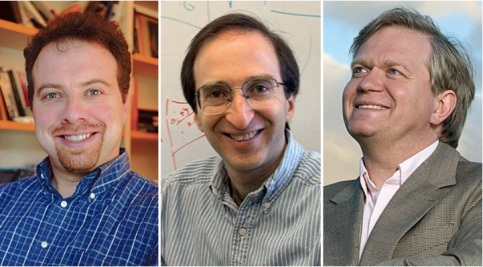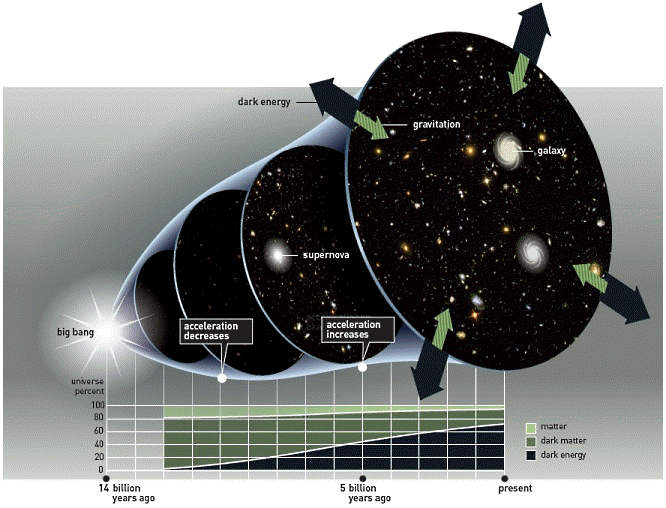|
News & Views item - October 2011 |
![]() 2011 Nobel Prize in Physics for the Discovery of Accelerating
Expansion of the Universe. (October 5, 2011)
2011 Nobel Prize in Physics for the Discovery of Accelerating
Expansion of the Universe. (October 5, 2011)
The 2011 Nobel Prize in Physics has been awarded to Saul Perlmutter, and jointly to Brian P. Schmidt and Adam G. Riess "for the discovery of the accelerating expansion of the Universe through observations of distant supernovae".

Johns Hopkins University; University Of California At Berkeley; Australian National University
From left, Adam Riess, Saul Perlmutter and Brian Schmidt
The media release issued by the Royal Swedish Academy of Sciences reads:
Robert Frost in Fire and Ice, 1920 wrote: Some say the world will end in fire, some say in ice...
_________________________________
What will be the final destiny of the Universe? Probably it will end in ice,
if we are to believe this year's Nobel Laureates in Physics. They have studied
several dozen exploding stars, called supernovae, and discovered that the
Universe is expanding at an ever-accelerating rate. The discovery came as a
complete surprise even to the Laureates themselves.
In 1998, cosmology was shaken at its foundations as two research teams presented
their findings. Headed by Saul Perlmutter, one of the teams had set to work in
1988. Brian Schmidt headed another team, launched at the end of 1994, where Adam
Riess was to play a crucial role.
The research teams raced to map the Universe by locating the most distant
supernovae. More sophisticated telescopes on the ground and in space, as well as
more powerful computers and new digital imaging sensors (CCD, Nobel Prize in
Physics in 2009), opened the possibility in the 1990s to add more pieces to the
cosmological puzzle.
The teams used a particular kind of supernova, called type Ia supernova. It is
an explosion of an old compact star that is as heavy as the Sun but as small as
the Earth. A single such supernova can emit as much light as a whole galaxy. All
in all, the two research teams found over 50 distant supernovae whose light was
weaker than expected - this was a sign that the expansion of the Universe was
accelerating. The potential pitfalls had been numerous, and the scientists found
reassurance in the fact that both groups had reached the same astonishing
conclusion.
For almost a century, the Universe has been known to be expanding as a
consequence of the Big Bang about 14 billion years ago. However, the discovery
that this expansion is accelerating is astounding. If the expansion will
continue to speed up the Universe will end in ice.
The acceleration is thought to be driven by dark energy, but what that dark
energy is remains an enigma - perhaps the greatest in physics today. What is
known is that dark energy constitutes about three quarters of the Universe.
Therefore the findings of the 2011 Nobel Laureates in Physics have helped to
unveil a Universe that to a large extent is unknown to science. And everything
is possible again.
___________________________________
Saul Perlmutter, U.S. citizen. Born 1959 in
Champaign-Urbana, IL, USA. Ph.D. 1986 from University of California, Berkeley,
USA. Head of the Supernova Cosmology Project, Professor of Astrophysics,
Lawrence Berkeley National Laboratory and University of California, Berkeley,
CA, USA.
www.physics.berkeley.edu/research/faculty/perlmutter.html
Brian P. Schmidt, U.S. and Australian
citizen. Born 1967 in Missoula, MT, USA. Ph.D. 1993 from Harvard University,
Cambridge, MA, USA. Head of the High-z Supernova Search Team, Distinguished
Professor, Australian National University, Weston Creek, Australia.
msowww.anu.edu.au/~brian/
Adam G. Riess, U.S. citizen. Born 1969 in
Washington, DC, USA. Ph.D. 1996 from Harvard University, Cambridge, MA, USA.
Professor of Astronomy and Physics, Johns Hopkins University and Space Telescope
Science Institute, Baltimore, MD, USA.
www.stsci.edu/~ariess/
To read more about this year's prize
Information for the Public Pdf 4,9 MB
Scientific Background Pdf 1 MB

The expansion of the Universe began with the Big Bang 14 billion years ago, but slowed down during the first several billion
years. Eventually it started to accelerate. The acceleration is believed to be driven by dark energy, which in the beginning constituted
only a small part of the Universe. But as matter got diluted by the expansion, the dark energy became more dominant. - Credit Nobel Foundation.
_________________________________________
Professor Bryan Gaensler* Australian Laureate Fellow at The University of Sydney and Director of the ARC Centre of Excellence for All-sky Astrophysics (CAASTRO) writes the following appraisal of the discovery.
Most science is incremental. Even the Nobel Prize often
goes to what might seem to the general public to be an obscure or technical
discovery. But in 2011, the Nobel Prize for Physics has recognised one of the
most jaw-dropping, unexpected, craziest results in the history of science - the
Universe is accelerating! The prize deservedly goes to the leaders of the teams
who first measured this effect - Australia's Brian Schmidt, and Americans Saul
Perlmutter and Adam Riess.
It's hard to overstate the profound fundamental change that this discovery
wrought on all of cosmology and discovery. In barely more than a decade, we have
gone from a comfortable picture of a mainly empty, gently decelerating,
Universe, to broad acceptance that we live in a bizarre cosmos, suffused with
as-yet-unexplained Dark Energy, tearing itself apart as it gains speed in all
directions.
The underlying concept was simple enough - that distant supernova explosions
could be used as 'standard candles' to measure the distance scale of the
Universe. But the brilliance of Schmidt, Perlmutter and Riess was in the
execution: these supernovae are rare and faint, and even just finding them right
after they occur is a feat in itself. But then one needs to carefully calibrate
and correct for a myriad of obfuscating and subtle effects in order to tease out
the faint signal of the accelerating Universe. It is a testament to the
expertise and skill of these astronomers that not only were they able to
convince themselves of this weak effect to a level such that they were
comfortable in publishing their work, but that after publication, the results
were quickly accepted and applauded by the community rather than questioned or
queried. The combination of brilliance, exquisite care and dogged determination
that Schmidt, Perlmutter, Riess and their teams applied to their work has been
rewarded by a Nobel Prize.
Beyond the celebration of these three Laureates, special acknowledgement must
also go to Professor Robert Kirshner of Harvard University. Bob Kirshner was the
PhD advisor and mentor for both Schmidt and Riess, and was very much the initial
inspiration and motivation behind the team's search for the supernovae that led
to this momentous discovery. The Nobel limit of three Laureates per year means
some tough calls inevitably need to be made. Kirshner's key contribution and
involvement in this work should not be overlooked.
Australia has much to celebrate by the award going to our own Brian Schmidt.
Media reports might claim Schmidt as an ĎAmerican-Australianí or an Ďadopted
Australianí, but make no mistake: despite his Montanan/Alaskan twang, Schmidt is
an Australian scientist who did his Nobel-prize work in Australia, and is still
very much an active researcher, leader and mentor within Australian astronomy.
Beyond his outstanding research record as recognised by the Nobel committee
today, what sets Brian apart is his unstinting commitment to Australian science
- he is extraordinarily generous with his time for students, public events,
review panels and committees; he often takes sides in debates that are to the
detriment of his own interests but represent what's best for the community; and
he has even funded research activities at ANU out of his own personal funds when
no other money was available. A devoted family man, a talented viniculturist, a
good friend to many within Australian astronomy, and now a Nobel Laureate -
congratulations to Brian Schmidt!
--------------------------------
*Did his postgraduate work at The University of Sydney and at CSIRO's Australia Telescope National Facility. Subsequently he held postdoctoral fellowships at the Massachusetts Institute of Technology and at the Smithsonian Astrophysical Observatory and was an associate professor of astronomy at Harvard University before returning to Australia.